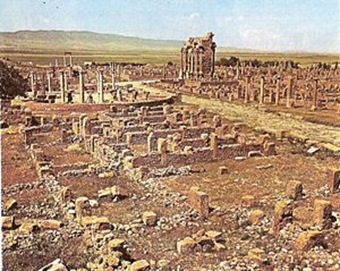The Timgad archaeological site spreads its sumptuous ruins across the heart of the Aurès mountains. Listed as a World Heritage site by UNESCO, the ancient Roman city built in the second century AD has become a rendezvous point for history enthusiasts.
 Standing at an altitude of 1070 metres on the northern slope of the Aures Mountains in south-east Batna, Timgad, the archaeological site of the Roman city which has come to be dubbed the "Numidian Pompeii", spreads its well preserved ruins across the horizon. Besides a seventh century Basilica, all of its ruins date from the second century AD. The excavations began in 1881-1959 and has since unearthed the remains of a triumphal arch, the Arch of Trajan - a forum, a library, baths and many private homes, all remarkably built with the same dimensions.
Standing at an altitude of 1070 metres on the northern slope of the Aures Mountains in south-east Batna, Timgad, the archaeological site of the Roman city which has come to be dubbed the "Numidian Pompeii", spreads its well preserved ruins across the horizon. Besides a seventh century Basilica, all of its ruins date from the second century AD. The excavations began in 1881-1959 and has since unearthed the remains of a triumphal arch, the Arch of Trajan - a forum, a library, baths and many private homes, all remarkably built with the same dimensions.
Ageless Graffiti
A Latin inscription, with a typographical error, chiseled into the stone steps surrounding the Forum square reads: “To hunt, bathe, play [games or gambling?], to laugh. That is life!". Although the flagrant Latin mistake tends to amuse a few scholars, the light it sheds into the romantic life or aspirations of the carefree author is much too enticing.
 A marble ball game is also set in stone. The area was probably a playground for the city’s youth. A bit further down the street stands a once busy open-air market which, despite its once a week market-day sales, also has fixed shops. From small shops to stalls that one cannot help but imagine as being well stocked. The signs on the shops are a rich source of information on their long dead owners: engraved vine branches on a particular shop indicate the local bar or drinking establishment. The neighbouring signs tell of dealers in fig, wheat, melons, cabbage, grapes, etc.
A marble ball game is also set in stone. The area was probably a playground for the city’s youth. A bit further down the street stands a once busy open-air market which, despite its once a week market-day sales, also has fixed shops. From small shops to stalls that one cannot help but imagine as being well stocked. The signs on the shops are a rich source of information on their long dead owners: engraved vine branches on a particular shop indicate the local bar or drinking establishment. The neighbouring signs tell of dealers in fig, wheat, melons, cabbage, grapes, etc.
14 Spas for 20,000 inhabitants
The military barracks built on a Roman road and established by the Roman Emperor Trajan in 100 AD is a perfect example of urban planning at the height of ancient Roman civilization. Ostensibly displaying the Roman grid plan, it has a square enclosure, an orthogonal design and two perpendicular routes running through the city.
 It has two cemeteries (north and south), public latrines, sewers and a water supply system built of baked clay pipes. Running water was already present in the third century when the city had only 20,000 inhabitants. There are 14 spas. At the entrance of one of its main relaxation centres: a solarium, a gym room and a cloakroom.
It has two cemeteries (north and south), public latrines, sewers and a water supply system built of baked clay pipes. Running water was already present in the third century when the city had only 20,000 inhabitants. There are 14 spas. At the entrance of one of its main relaxation centres: a solarium, a gym room and a cloakroom.
 The ancient Romans were fond of sauna and loved to while away their time in this hot room after which they would move into a cold water bath before getting a soothing massage with aromatic olive oil (lavender or rosemary, or perhaps both ...). The elegant mosaic floors of the bathhouses, discovered in mint condition, are on display in the museum at the site’s entrance.
The ancient Romans were fond of sauna and loved to while away their time in this hot room after which they would move into a cold water bath before getting a soothing massage with aromatic olive oil (lavender or rosemary, or perhaps both ...). The elegant mosaic floors of the bathhouses, discovered in mint condition, are on display in the museum at the site’s entrance.
World Heritage
Along the alley leading to the Arch of Trajan the deep tracks in the paved lanes bear testimony to the passage of powerful carts that once animated them, just like in Pompeii. After five centuries of commercial traffic, to Mauritania, Tunisia, or Constantine, further north, the city declines along with the rest of the Roman Empire suffering invasions by Vandals and Byzantines.
Though it was classed as a World Heritage site by UNESCO in 1982, Timgad is far from having revealed the last of its archaeological treasures: there are still a number of quarters that remain to be dug, especially west of the arch.
But for now, the modern buildings bristling with satellite dishes to the east of the vestiges of this once influential city tells of two tales: the past and present.
Author: Prince Ofori-Atta | Source: Afrik News [July 21, 2010]